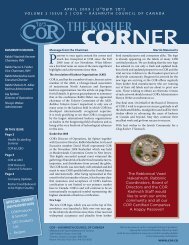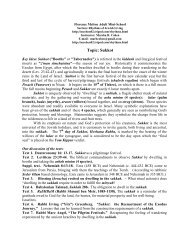The Religious Policy of Xerxes and the "Book of Esther"
The Religious Policy of Xerxes and the "Book of Esther"
The Religious Policy of Xerxes and the "Book of Esther"
Create successful ePaper yourself
Turn your PDF publications into a flip-book with our unique Google optimized e-Paper software.
XERXES AND THE BOOK OF ESTHER-LITTMAN I47<br />
<strong>The</strong>re are many <strong>the</strong>ories as to <strong>the</strong> origin <strong>of</strong> <strong>the</strong> festival, that<br />
it dates from <strong>the</strong> period <strong>of</strong> Judah Maccabee, that <strong>the</strong> name <strong>of</strong><br />
<strong>the</strong> festival derives from <strong>the</strong> Hebrew purah "wine press" <strong>and</strong><br />
<strong>the</strong> festival is a Judaization <strong>of</strong> <strong>the</strong> Greek festival <strong>of</strong> Pithoigia<br />
("opening <strong>the</strong> Wine Casks")8 or that it was adopted by <strong>the</strong><br />
Jews during <strong>the</strong> Babylonian Exile, based on <strong>the</strong> ritual <strong>of</strong> <strong>the</strong><br />
Babylonian New Year at which <strong>the</strong>re was a portrayal <strong>of</strong> <strong>the</strong><br />
victory <strong>of</strong> Babylon's deities Marduk <strong>and</strong> Ishtar over those <strong>of</strong><br />
neighboring Elam, Humman <strong>and</strong> Kiririsha, <strong>and</strong> that <strong>the</strong> Jews<br />
later adapted <strong>the</strong> story when <strong>the</strong>y came under Babylonian<br />
rule, <strong>and</strong> made Mordecai <strong>and</strong> Es<strong>the</strong>r triumph over Haman<br />
<strong>and</strong> his wife Zeresh. <strong>The</strong> name <strong>of</strong> <strong>the</strong> festival Purim could be<br />
connected with <strong>the</strong> Babylonian word puru "lot" since on New<br />
Year's Day <strong>the</strong> gods <strong>of</strong> Babylon were said to meet <strong>and</strong> cast lots<br />
to determine <strong>the</strong> destinies <strong>of</strong> man for <strong>the</strong> next year.9 Ano<strong>the</strong>r<br />
<strong>the</strong>ory suggests that <strong>the</strong> word Purim is a corruption <strong>of</strong><br />
Phruraia or Phurdaia <strong>and</strong> <strong>the</strong> original name derived from <strong>the</strong><br />
Persian Farwadigan, a five day All Souls festival celebrated at<br />
<strong>the</strong> end <strong>of</strong> <strong>the</strong> year. However, this <strong>the</strong>ory, based too heavily<br />
on textual errors <strong>of</strong> <strong>the</strong> Septuagint <strong>and</strong> Josephus, has been<br />
largely rejected,1 though it is conceded that <strong>the</strong>re are similarities<br />
between <strong>the</strong> Farwadigan festival <strong>and</strong> Purim, since<br />
both are celebrated in <strong>the</strong> month <strong>of</strong> Adar <strong>and</strong> both are spring<br />
renewal rites.11<br />
8 For a summary <strong>of</strong> <strong>the</strong>se <strong>the</strong>ories <strong>and</strong> bibliography see Paton, op.<br />
cit., 83-84.<br />
9 H. Zimmern, Zur Frage nach dem Ursprunge des Purimfestes,"<br />
ZAW ii (I89I) I57-69; P. Jensen, "Elamitische Eigennamen. Ein<br />
Beitrag zur Erklarung der elamitischen Inschriften," WZKM 6 (I892)<br />
47-70, 209-226. This <strong>the</strong>ory has many attractive elements in it, though<br />
it is not totally convincing. Gaster, op. cit., 8, attacks <strong>the</strong> <strong>the</strong>ory on<br />
<strong>the</strong> grounds that <strong>the</strong> Babylonian New Year was observed, not in<br />
March, but in Nisan (April) <strong>and</strong> lasted for a period <strong>of</strong> ten days, <strong>and</strong><br />
that <strong>the</strong>re is no evidence that <strong>the</strong> Babylonian New Year was ever<br />
called "Day <strong>of</strong> Lots". It is doubtful, Gaster fur<strong>the</strong>r asserts, that <strong>the</strong>re<br />
was a major Elamite god named Humman, only a minor Khumban or<br />
Khuba.<br />
10 Gaster, op. cit., 9-I0.<br />
11 Lewy, op. cit., 137-8.





